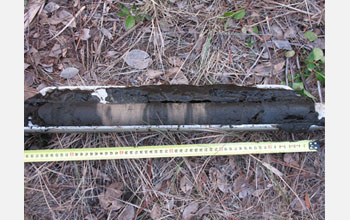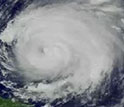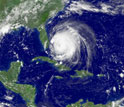News Release 09-151
Hurricane Seasons Are More Active
Study examined evidence of hurricanes going back 1,500 years, identified factors that contribute to more active hurricane seasons

A sediment core sample collected in a laguna along the Florida Panhandle.
August 12, 2009
View a media briefing with Penn State researcher Michael Mann, lead author of the paper.
This material is available primarily for archival purposes. Telephone numbers or other contact information may be out of date; please see current contact information at media contacts.
For many Americans who live on the Atlantic coast, Andrew, Ivan and Katrina are more than just names--they are reminders of the devastating impact of cyclonic activity in the region during hurricane season. If it seems like hurricane seasons have been more active in recent years, you're on to something. According to a paper published in the August 13 issue of Nature, the frequency and strength of these powerful storms has grown in recent decades.
"We are at levels now that are about as high as anything we have seen in the past 1,000 years," said Michael Mann, director of the Earth System Science Center at Pennsylvania State University and the lead author of the paper. Mann and his collaborators, Jeffrey P. Donnelly of the Woods Hole Oceanographic Institution, Jonathan D. Woodruff of the University of Massachusetts and Zhihua Zhang of Pennsylvania State University examined sediment samples from across the North Atlantic coast and statistical models of historic hurricane activities.
Their analysis allowed them to measure the severity of hurricane seasons over the past 1,500 years. The sediment samples match up relatively well with the computer models, both of which show a period of high activity around 1,000 AD, followed by a lull in activity. This medieval peak rivals and possibly exceeds the level of activity seen in recent decades.
The study also adds validity to the theory that two factors fuel higher hurricane activity, namely the La Niña effect and high surface temperatures over the ocean. If climate change continues to warm ocean waters, Mann said, it could lead to more active hurricane seasons. This hurricane season, which has yet to see a named storm, is lighter than usual, Mann said, because of the El Niño effect, which is believed to have the opposite effect of La Nina patterns.
-NSF-
-
View Video
An interview with Michael Mann, lead author of the paper on historical hurricane seasons.
Credit and Larger Version -
A satellite image of an Atlantic hurricane.
Credit and Larger Version
Media Contacts
Dana W. Cruikshank, NSF, (703) 292-7738, email: dcruiksh@nsf.gov
Related Websites
More information on the Nature paper: http://live.psu.edu/story/40850/rss49
The U.S. National Science Foundation propels the nation forward by advancing fundamental research in all fields of science and engineering. NSF supports research and people by providing facilities, instruments and funding to support their ingenuity and sustain the U.S. as a global leader in research and innovation. With a fiscal year 2023 budget of $9.5 billion, NSF funds reach all 50 states through grants to nearly 2,000 colleges, universities and institutions. Each year, NSF receives more than 40,000 competitive proposals and makes about 11,000 new awards. Those awards include support for cooperative research with industry, Arctic and Antarctic research and operations, and U.S. participation in international scientific efforts.
Connect with us online
NSF website: nsf.gov
NSF News: nsf.gov/news
For News Media: nsf.gov/news/newsroom
Statistics: nsf.gov/statistics/
Awards database: nsf.gov/awardsearch/
Follow us on social
Twitter: twitter.com/NSF
Facebook: facebook.com/US.NSF
Instagram: instagram.com/nsfgov


